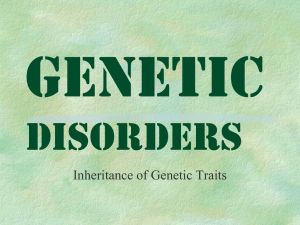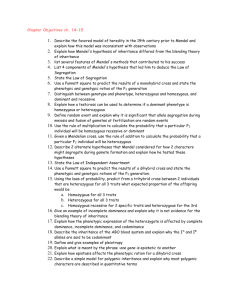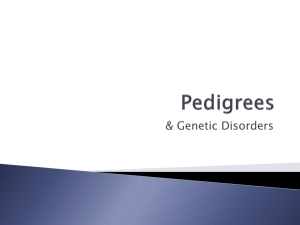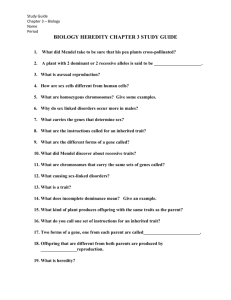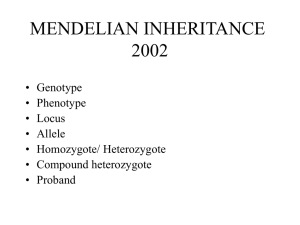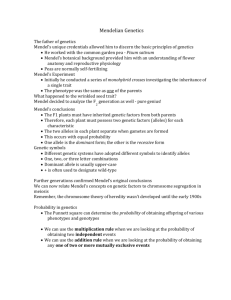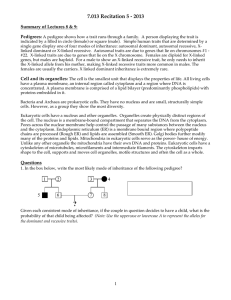Review Sheet - University of San Diego
advertisement
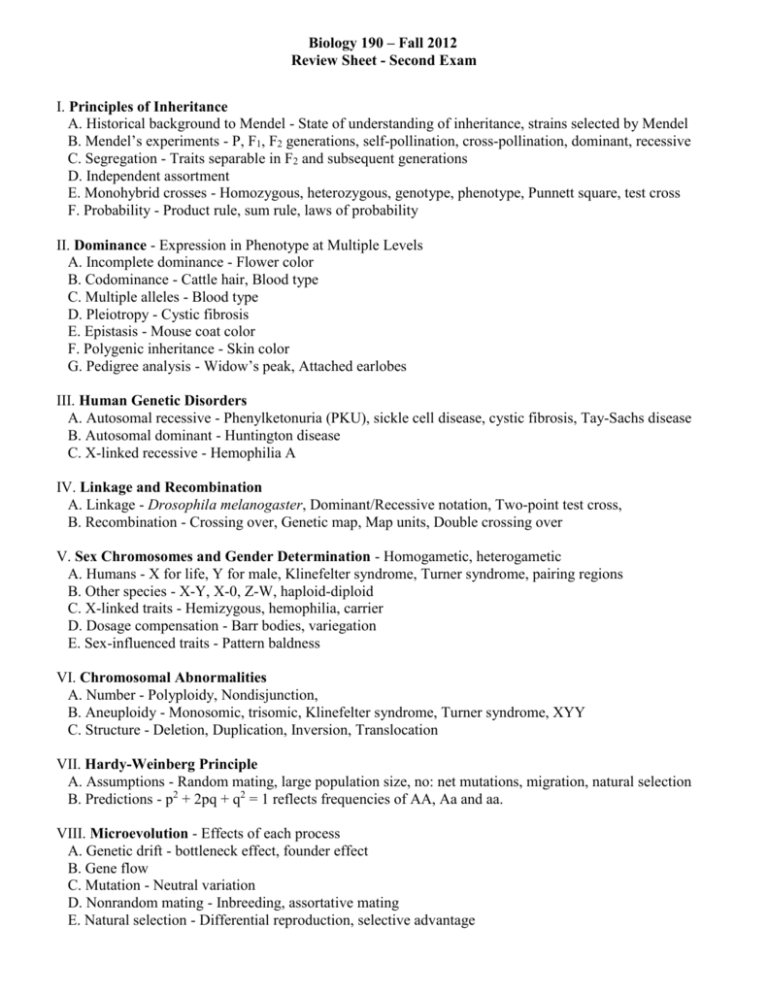
Biology 190 – Fall 2012 Review Sheet - Second Exam I. Principles of Inheritance A. Historical background to Mendel - State of understanding of inheritance, strains selected by Mendel B. Mendel’s experiments - P, F1, F2 generations, self-pollination, cross-pollination, dominant, recessive C. Segregation - Traits separable in F2 and subsequent generations D. Independent assortment E. Monohybrid crosses - Homozygous, heterozygous, genotype, phenotype, Punnett square, test cross F. Probability - Product rule, sum rule, laws of probability II. Dominance - Expression in Phenotype at Multiple Levels A. Incomplete dominance - Flower color B. Codominance - Cattle hair, Blood type C. Multiple alleles - Blood type D. Pleiotropy - Cystic fibrosis E. Epistasis - Mouse coat color F. Polygenic inheritance - Skin color G. Pedigree analysis - Widow’s peak, Attached earlobes III. Human Genetic Disorders A. Autosomal recessive - Phenylketonuria (PKU), sickle cell disease, cystic fibrosis, Tay-Sachs disease B. Autosomal dominant - Huntington disease C. X-linked recessive - Hemophilia A IV. Linkage and Recombination A. Linkage - Drosophila melanogaster, Dominant/Recessive notation, Two-point test cross, B. Recombination - Crossing over, Genetic map, Map units, Double crossing over V. Sex Chromosomes and Gender Determination - Homogametic, heterogametic A. Humans - X for life, Y for male, Klinefelter syndrome, Turner syndrome, pairing regions B. Other species - X-Y, X-0, Z-W, haploid-diploid C. X-linked traits - Hemizygous, hemophilia, carrier D. Dosage compensation - Barr bodies, variegation E. Sex-influenced traits - Pattern baldness VI. Chromosomal Abnormalities A. Number - Polyploidy, Nondisjunction, B. Aneuploidy - Monosomic, trisomic, Klinefelter syndrome, Turner syndrome, XYY C. Structure - Deletion, Duplication, Inversion, Translocation VII. Hardy-Weinberg Principle A. Assumptions - Random mating, large population size, no: net mutations, migration, natural selection B. Predictions - p2 + 2pq + q2 = 1 reflects frequencies of AA, Aa and aa. VIII. Microevolution - Effects of each process A. Genetic drift - bottleneck effect, founder effect B. Gene flow C. Mutation - Neutral variation D. Nonrandom mating - Inbreeding, assortative mating E. Natural selection - Differential reproduction, selective advantage Biology 190 – Fall 2012 Review Sheet - Second Exam IX. Genetic Variation A. Variation within Populations - polymorphism B. Variation between populations - geographic variation, clinal variation C. Preservation of variation 1. Balanced polymorphism - heterozygote advantage, frequency-dependent selection D. Natural selection - stabilizing selection, directional selection, diversifying selection, anagenesis, cladogenesis X. Reproductive Isolating Mechanisms A. Prezygotic barriers - Habitat, temporal, behavioral (sexual), mechanical and gametic isolation B. Postzygotic barriers - Reduced hybrid viability, reduced hybrid fertility, and hybrid breakdown XI. Speciation A. Allopatric - Geographical barriers, conditions favoring allopatric speciation, adaptive radiation on islands B. Sympatric - Plants, autopolyploidy, allopolyploidy, animals C. Adaptive Radiation Review Session – Sunday, Nov 11, 3:00-5:00, ST232


